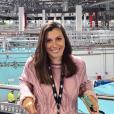Imaging technology has the ability to capture and display gamma radiation
A new imaging technology developed at ANSTO makes it possible to image, identify and locate gamma-ray radiation in a safe and timely manner.

Showing 821 - 840 of 927 results
A new imaging technology developed at ANSTO makes it possible to image, identify and locate gamma-ray radiation in a safe and timely manner.
ANSTO is collaborating on a project funded with an Australian Research Council linkage grant that will develop new materials and better systems for efficiently storing hydrogen gas.
Experiments at the Synchrotron enable researchers to produce a 3D structure of a molecular scaffold with role in cancer
Melbourne researchers have used the Australian Synchrotron to produce structure of molecule known to play a critical role in the development and spread of aggressive cancer.

In Australia and the Southeast Asia basin, the ANSTO facility offers a wide range of unique nuclear-beam techniques for cultural heritage research.

Hamish is a Chartered Engineer (CEng, MIChemE) with plenty of experience of the pharmaceutical industry and fresh experience in nuclear medicine having recently joined ANSTO.
Guide to successful proposals and experiments at the Powder Diffraction beamline.


ANSTO recently re-started the OPAL Reactor after a six-month shutdown for essential maintenance and the installation of an upgraded facility.
Phase contrast tomography shows great promise in early stages of study and is expected to be tested on first patients by 2020.
MABI instrument can determine both the concentration and source of black carbon pollution in the atmosphere.
Professor of Soil Science at The University of Queensland, Peter Kopittke and partner investigator Prof Enzo Lombi of the University of SA are very optimistic about the use of a new synchrotron-based imaging technique that captures in 3D the complex interaction of soil and root.
Innovative medical device Rhenium-SCT® therapy for non-melanoma skin cancer is now available in Australia
A team of Melbourne researchers and international partners from Italian Instituto Nazionale de Fisica Nucleare (INFN) and CERN, who are developing radiation-hardened semiconductor chips, used the unique state-of-art high energy ion microprobe on the SIRIUS ion accelerator at ANSTO’s Centre for Accelerator Science to test a prototype radiation-resistant computer chip
Two early career nuclear scientists who received international scholarships have spent time in the Nuclear Fuel Cycle group at ANSTO are making progress on their work to improve nuclear fuel.


Role at ANSTO

Dr Anita D’Angelo is a Beamline Scientist for the Powder Diffraction beamline.